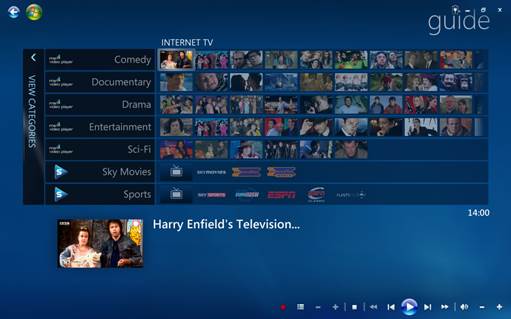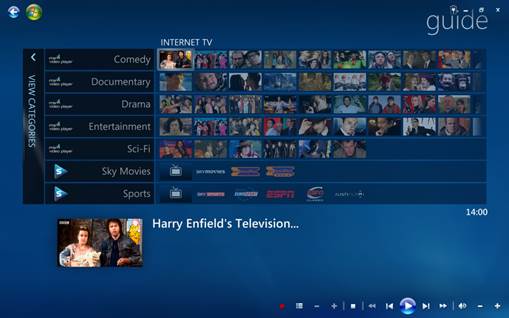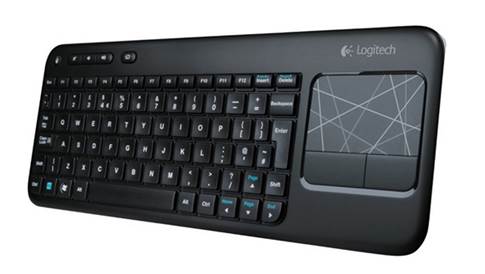Alternatives to WMC
As we mentioned, WMC isn’t the only
TV-friendly media-playing application on the block. If you installed Boxee
earlier then start it now. It requires a free account (a verified email is all
that is needed), which can be created during installation or beforehand via the
website. Once signed in, it runs as a full-screen application and can be
navigated with a mouse and keyboard. Pressing the Escape (Esc) key on the
keyboard shows the navigation menu from any screen.
Before starting, set your location by
clicking the cog-wheel icon at the top left, choose Look and Feel, click
Location and type in your nearest city.
Boxee includes access to movie content via
Mubi (wwwmubi.com) and Openfilm (www.openfilm.com). All MUBI films are pay per view,
while Openfilm is free for all to access.

MSN
Video Player has dozens of free old TV programs
Fortunately, you aren’t limited to what’s
in the preset categories. Click on the Apps icon in the main menu, then select
Apps Library to browse dozens of free video, photo and music applications,
including online video sites such as Youtube, Vimeo and music-video service
Vevo, photo sites such as Flickr and Picasa, and educational services such as
the educational resources like the Open University’s podcasts.
There is also a web browser built in (the
Boxee Browser) but this is clunky to use and it’s best to exit to Windows and
instead use a normal browser such as Internet Explorer or Firefox.
To play content from your PC or home
network, click Files in the main menu and browse for content. DVDs and CDs can
be played, too, but currently Boxee does not support Blu-ray playback. Finally,
while we think most people’s TV-viewing needs will be well-served by either WMC
or Boxee, the aforementioned XBMC is at least worth a look especially if you
are intending mainly to use media files that are stored on your PC or home
network. It also works on Linux PCs or Apple Macintosh computers, if either of
those are your preference.
Back to Windows
With a PC connected to the TV, there is
nothing to stop you using Windows as normal. The only problem is that the menus
can be small on a large TV but there is a remedy. In Windows 7, right-click an
empty part of the Desktop and choose Screen Resolution. Click the link labeled
‘Make text and other items larger or smaller’, then choose the Medium or Large
radio button (try both to see which works best). Click Apply, then log off and
log on to Windows again. All text and menu items should now be larger and more
legible.

The
Tuner Free MCE add-on for Windows Media Center has live and catch-up TV
Vista users should right-click the Desktop,
choose Personalize, then click Adjust font size (DPI)’. Click Larger scale
followed by Apply, then restart the PC.
In XP, right-click the Desktop, choose
Properties, then click the Settings tab. Click Advanced, and on the General tab
choose ‘Large size (120 DPI)’ from the dropdown menu. Click OK, then click Yes
if prompted then click Close to restart the PC.
As well, some online video services have
websites optimized for use on TVs you may decide that using or installing
additional media-playing software is unnecessary. See Youtube XL {wwwyovttabe.com/xt)
and iPlayer Bigscreen (www.bbc.cavk/iplayer/bigscreen), for starters. These use
bigger buttons and menus, making them easier to navigate.
Remotes and keyboards
Of course, the whole idea of connecting a
computer to a TV is so that it can be used from the sofa. We’d suggest that a
wireless keyboard is good idea: compact models with media playback keys, such
as the Microsoft Wireless Desktop 3000 (www.snipca.c0m/X4509), are best. If you
can afford it, a device like Gyration’s Air Mouse is worth considering, as it
makes it much easier to control Windows from a distance.

A
wireless keyboard is a good way to control your internet TV from the sofa
However, a remote control is the most
comfortable method for navigating the likes of WMC, Boxee and XBMC.
If you decide to add a TV tuner card to
your PC (see box headed Add a TV tuner’ at the end of this article), these
typically come with their own remote control that’s likely to be compatible
with WMC, Boxee and XBMC. And for those who own a suitable Apple gadget, such
as an iPhone or iPad, there is a free Boxee Remote app (www.snipca.com/X45i3)
which controls the Boxee via your router.
Smarter than the average TV
We hope that our advice shows that there’s
really no need to spend hundreds of pounds in order to get a smarter TV.
Really, the entire setup can be summarized
like this: attach a basic PC to your TV, connect it to the internet and away
you go. Obviously, customizing the system so it works just the way you takes
effort but it is worthwhile: a homemade smart TV will be better than anything
you can currently buy in the shops.
Making the connection
HDMI is the best choice for connecting the
computer to a TV as both graphics and audio can be sent down the same cable.
Many newer PCs have an HDMI port built in but, if not, ask the manufacturer if
an adapter is available that supports both audio and video.
If not, buy a DVI to HDMI converter and a
separate cable to connect the PC's audio output to the TV. A more expensive
option is the Q-Waves HD (www.snipca. com/X4502), which provides a wireless
HDMI connection (including audio) from the PC to the TV and needs only a USB
port on the PC.
For PCs with a 15-pin VGA connector, a VGA
to HDMI converter box can be bought the PC's audio output can also be connected
to this.
If your TV has a DVI or VGA input, these
can also be used instead of HDMI, but again the PC's audio output needs to be
connected separately. Blinkbox, the online video service, has a useful guide to
identifying and using the various connectors.
Finally, if your PC has an S-Video
connector and the TV has a Scart or S-Video connector, a combination adapter
cable with both types of connector plus audio Phono connectors.
Add a TV tuner
You might think that as the PC is connected
to a TV, adding a TV tuner is a bit pointless. But fitting a TV tuner means the
PC’s hard disk can be used as digital video recorder, even while you are
watching the main TV.
There are many Freeview tuners, both as
internal cards for a desktop PC, or external USB models for laptops or those
who don’t want to open up the PC. Windows Media Center on Windows 7 supports up
to three separate tuners (Vista supports two), so it’s possible to record three
channels at once, or watch one live while recording two others.
Tuner cards also come with their own
playback software, which is useful for XP users, although it is not needed in
Vista or 7.
The AverTVTwinstarA825 is a twin-tuner USB
model. Analogue tuners are also still available, but bear in mind that these
will be effectively useless when the switchover to digital TV is completed.
In all cases, using an external aerial will
give the best results, so you may need a splitter for an existing aerial if it
is in use and possibly a signal booster.